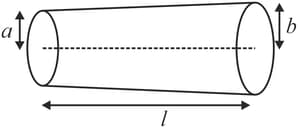MEDIUM
JEE Advanced
IMPORTANT
Earn 100
Consider resistor of uniform cross-sectional area connected to a battery of internal resistance zero. If the length of the resistor is doubled by stretching it, then
50% studentsanswered this correctly
Important Questions on Electric Current and Circuits
EASY
JEE Advanced
IMPORTANT
PHYSICS for Joint Entrance Examination JEE (Advanced) Electrostatics and Current Electricity>Chapter 5 - Electric Current and Circuits>Concept Application Exercise>Q 1
How many electrons per second pass through a section of wire carrying a current of ?EASY
JEE Advanced
IMPORTANT
PHYSICS for Joint Entrance Examination JEE (Advanced) Electrostatics and Current Electricity>Chapter 5 - Electric Current and Circuits>Concept Application Exercise>Q 2
A current of is maintained in a wire for . In this time,
(a) how much charge and
(b) how many electrons flow through the wire?
EASY
JEE Advanced
IMPORTANT
PHYSICS for Joint Entrance Examination JEE (Advanced) Electrostatics and Current Electricity>Chapter 5 - Electric Current and Circuits>Concept Application Exercise>Q 3
If of electrons flows through a wire in , what are the total charge that passes through the wire and the magnitude of the current?EASY
JEE Advanced
IMPORTANT
PHYSICS for Joint Entrance Examination JEE (Advanced) Electrostatics and Current Electricity>Chapter 5 - Electric Current and Circuits>Concept Application Exercise>Q 4
The current in a wire varies with time according to the equation , where is in and is in . Calculate the quantity of charge that passes through a cross-section of the wire during the time to .HARD
JEE Advanced
IMPORTANT
PHYSICS for Joint Entrance Examination JEE (Advanced) Electrostatics and Current Electricity>Chapter 5 - Electric Current and Circuits>Concept Application Exercise>Q 5
A wire has a resistance What will be its resistance if
it is double on itself and
it is stretched so that
its length is doubled and its radius is halved.
EASY
JEE Advanced
IMPORTANT
PHYSICS for Joint Entrance Examination JEE (Advanced) Electrostatics and Current Electricity>Chapter 5 - Electric Current and Circuits>Concept Application Exercise>Q 6
If a copper wire is stretched to make it longer, what is the percentage change in its resistance?MEDIUM
JEE Advanced
IMPORTANT
PHYSICS for Joint Entrance Examination JEE (Advanced) Electrostatics and Current Electricity>Chapter 5 - Electric Current and Circuits>Concept Application Exercise>Q 8
The figure shows a conductor of length having a circular cross-section.

The radius of cross-section varies linearly from to . The resistivity of the material is . Assuming that , find the resistance of the conductor.
HARD
JEE Advanced
IMPORTANT
PHYSICS for Joint Entrance Examination JEE (Advanced) Electrostatics and Current Electricity>Chapter 5 - Electric Current and Circuits>Archives>Q 3
An infinite line charge of uniform electric charge density lies along the axis of an electrically conducting infinite cylindrical shell of radius . At time , the space inside the cylinder is filled with a material of permittivity and electrical conductivity . The electrical conduction in the material follows Ohm's law. Which one of the following graphs best describes the subsequent variation of the magnitude of current density at any point in the material?